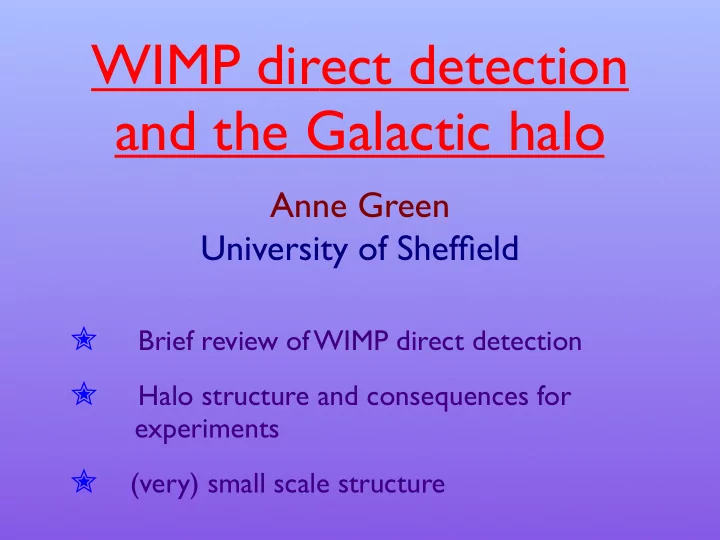

WIMP direct detection and the Galactic halo Anne Green University of Sheffield ✮ Brief review of WIMP direct detection ✮ Halo structure and consequences for experiments ✮ (very) small scale structure
WIMP direct detection Via elastic scattering in the lab: χ + N ⇒ χ + N Detect recoil energy via ionisation, scintillation and/or heat.
Event rate m χ = 100 GeV, ρ = 0.3 GeV/cm 3 , σ =10 -5 pb and assuming ‘standard’ halo model.
WIMP smoking guns Earth’s orbit annual modulation and direction dependence [Drukier, Freese & Spergel] [Spergel ]
Annual modulation m χ = 100 GeV, ρ = 0.3 GeV/cm 3 , σ =10 -5 pb (‘standard’ halo model) Differential event rate WIMP flux (June and December) Annual modulation amplitude (event rate in June minus mean event rate)
Direction dependence WIMP flux Recoil rate [Morgan, Green & Spooner]
Experimental considerations (as seen by a theorist....) General Need low energy threshold and low backgrounds. Annual modulation Signal is very small (a few per-cent) => need stable operation of a large mass detector (and eliminate other possible causes of a time dependence of the event rate). Direction dependence Much cleaner signal: only of order 10 events required for a positive detection, hard for backgrounds to mimic. Need a detector which can measure the direction as well as the energy of nuclear recoil.
D irectional R ecoil I dentification F rom T racks [UKDMC]
Modelling the Milky Way halo Standard halo model isothermal sphere: spherical, isotropic, smooth ρ ~ r -2 Observations and simulations indicate that dark matter halos are (to some extent) triaxial, anisotropic and contain substructure. Is the standard halo model a good approximation? For the mean signal (averaged over time and direction): Perhaps For the annual modulation and direction dependence: No
Observations: Of other galaxies: b/a > 0.8, 0.2 < c/a < 1.0 [e.g. Sackett & Merrifield reviews] Polar ring galaxy NGC4650 observed by Hubble [Merrifield] X-ray and optical images of NGC 720.
Milky Way: c/a ~ 0.7-0.9 from warping and flaring of gas disk [Olling & Merrifield] Contains >10 satellite galaxies Limit on flattening from kinematics of Sagittarius dwarf tidal debris? Johnston
Simulations: [Moore] Triaxiality and anisotropy vary significantly between halos and also as a function of radius (closer to spherical and isotropic in the inner regions). [e.g. Moore et al.] Simulations with gas cooling produce more spherical halos. [Dubinski, Kazantzidis et al.] Contain large amounts of substructure. [Klypin et al., Moore et al.]
Halo modelling Standard approach: use analytic models which are solutions of the collisionless Boltzmann equation (i.e. assume the phase space distribution function has reached a steady state). For spherical and isotropic systems there is a unique relationship: r(r) => f(v) Triaxial and anisotropic systems are far more complicated; assumptions have to be made about the form of the anisotropy or velocity distribution.
An example Logarithmic Ellipsoidal model [Evans, Carollo & de Zeeuw] Simplest, triaxial generalisation of the isothermal sphere, f(v) is a multi-variate gaussian in conical co-ordinates. Triaxiality and anisotropy independent of radius. Velocity distribution solid line: standard halo model other lines: parameters choosen to reproduce range of properties of observed/simulated halos
Differential event rate Exclusion limits from IGEX experiment Annual modulation amplitude Annual modulation phase
Standard halo LGE model WIMP flux Recoil rate ~1000s of events would be required to differentiate between recoil rate in ‘next/current’ generation detectors. [Morgan, Green & Spooner]
Formation of dark matter halos Structure forms hierarchically: halos form from the merger and accretion of smaller sub-halos. Simulation of the formation of a Galaxy Cluster by Juerg Diemand, Joakim Stadel, Ben Moore (University of Zurich) on the zBox Supercomputer at the University of Zurich.
Signals from a WIMP stream Peak direction deviates from Sun’s motion. Step in the differential event Detectable with ~200 events rate (position and height (depending on density and modulated annually). velocity of stream). [Gondolo, Freese & Newberg] [Morgan, Green & Spooner]
Small scale structure WIMP direct detection probes the dark matter distribution on sub-mpc scales (c.f. ~100pc resolution of Galaxy simulations). How clumpy is the small scale dark matter distribution? This depends on the structure and evolution of the first generation of DM halos to form, which in turn depends on the nature of the dark matter and its interactions
WIMP microphysics [Hofman, Schwarz & Stocker; Berezinsky, Dokuchaev & Eroshenko; Green, Hofmann & Schwarz; Loeb & Zaldarriaga] After freeze-out (chemical decoupling) WIMPS carry on interacting kinetically with radiation. x χ+χ ⇔ X + � X χ+ � X � ⇒ χ+ � X Energy transfer erases v. small scale density perturbations (collisional damping). After kinetic decoupling WIMPs free-stream, erasing perturbations on slightly larger scales. Net result: perturbations on (comoving) scales smaller than 1pc are erased. Properties of first halos: r ~ 0.01 pc, mass ~ 10 -6 M sun, present day overdensity (assuming they survive....) ~10 6
Numerical simulations [Diemand, Moore & Stadel] Re-simulate a small region starting at z=350 (when the fluctuations are still linear) up until z=26 (when the high resolution region begins to merge with surrounding low resolution regions). Do they survive do the present day? Possibly destroyed by interactions with stars? [Zhao, Taylor, Silk & Hooper] Extrapolating sub-structure mass function to small masses, tens of per-cent of MW mass in bound sub-halos, BUT very sensitive to slope of the sub-halo mass function.
Summary ✮ Two potential WIMP smoking guns: annual modulation and direction dependence. ✮ Signals depend on the local WIMP distribution. The ‘standard’ halo model is unlikely to be a ✮ good approximation. Tidal streams are potentially detectable ✮ (WIMP astronomy). ✮ How smooth is the dark matter distribution on small scales?
Recommend
More recommend